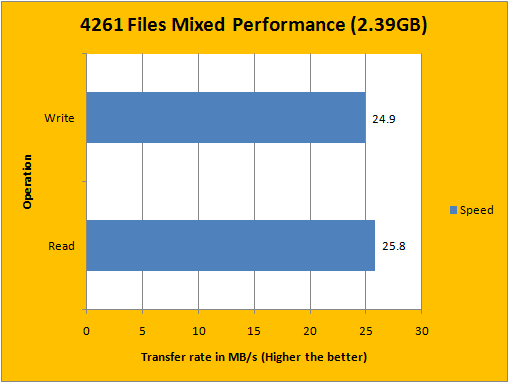Page 4 - Performance Benchmarks
For our tests, the QNAP TS-439 Pro is placed in the networking room in our basement, where all the network outlets in the building leads to. Our QNAP TS-439 Pro is placed on the right of the Thecus N4100PRO and QNAP TS-409 in our storage room, respectively. Our test station is located two stories away from the NAS to simulate real world performance in a centralized networking environment. A NETGEAR GS-108 Gigabit switch handles the communication between the two.
Test system as follows:
- Intel Core 2 Extreme QX9650 @ 3.50 (333*10.5, Yorkfield/12MB L2)
- Noctua NH-U12P w/Noctua NF-P12 + Arctic Cooling MX-2
- Asus Striker II NSE
- Super Talent Project X PC3-14400 2x1GB @ 6-6-6-18
- Western Digital 500GB AAKS 7200RPM 16MB PMR SATA2
- NEC AD-7170A 18X DVD+/-RW
- Gigabyte Radeon HD 4850 1GB Passive
- Auzentech X-Fi Prelude
- Silverstone KL-02; Noctua NF-P12 - Front (Asus Q-Fan), Noctua NF-S12-1200 - Back (Asus Q-Fan)
- Seasonic M12II 500W
- Microsoft Windows Vista Ultimate SP2
There are two hard drives installed in our QNAP TS-439 Pro: A Seagate Barracuda 7200.10 320GB and Western Digital Caviar KS 250GB, configured in independent single disks, and formatted in the EXT4 file system. All performance tests are measured from the Seagate Barracuda 7200.10 320GB drive. To read means to copy files from the network attached storage system to the test system, and to write means to copy files from the test system to the network attached storage system.

Since there were so many claims about the excellent performance of QNAP's TS-439 Pro, I was definitely excited to see what the maximum throughput of the NAS was in real life applications. While I don't have any RAID configurations set up at the moment, the second I started transferring data to the new machine, I couldn't believe my eyes. The performance is unbelievable and insane compared to anything I've used before. While most units in the past can barely crack 20 to 25MB/s in our proprietary real life performance benchmarks, the QNAP TS-439 Pro shattered all our previous records and my initial expectations in delivering over 60MB/s of sustained average speed. That's 2 to 3 times as fast as anything I've tested in the segment before with the same constant variables. With read and write situated at 61.5MB/s and 60.9MB/s, respectively, the QNAP TS-439 Pro is an incredible fast network attached storage system. Moving 160GB of data in a day to the system didn't prove to be as much as a chore as it was before!

Our proprietary multifile read/write benchmark (Now redesigned to work more accurately with large storage systems) did in fact slow significantly when we tried to copy 4261 files totaling 2.39GB into the system. While this may be partially inhibited by drive speed on both ends, this usually tests CPU and memory of the target device as well -- it would be fairly disastrous if the NAS system was underpowered in both regards. The QNAP TS-439 Pro kept up pretty well, and resulted in approximately 25MB/s sustained performance for both read and write, as shown in the graph above.
As far as ungraphed data are concerned, the new Intel Atom N270 CPU is significantly more powerful than the underpowered 500MHz Marvell used in the TS-409. Memory usage monitoring also shows that its 1GB of RAM also improves performance with simultaneous multiple user access; which proves itself to be competent even at full load. Inevitably, there will be a performance drop -- no doubt. During our tests, I actually tried one computer copying 80GB data to Disk 1, one computer copying another 80GB of data to Disk 2, plus another streaming my favorite episodes of Top Gear off the server. It drops to around 30-40MB/s each with no lag in video streaming. I would say that it is pretty darn good! However, it already pretty much pushed the limits of the CPU; it would be much better if it is equipped with a dual core Atom processor -- especially at the price range the TS-439 Pro is in. Since it offers dual Gigabit LAN for this purpose, why not offer a dual core CPU as well?

With two hard drives installed, our QNAP TS-439 Pro's power consumption is measured to be 7-9W more than the TS-409. It's not very significant; and that's to mention that the TS-439 Pro is significantly more powerful than its predecessor. I believe that the relatively insignificant increase in power consumption is well justified by all means. The peak power usage during initial startup was 63W; which drops to a sustained 34W when it's loading. Idle power usage with both drives running is 32W. When it's under full load with both drives (Three computers accessing both drives on the system at the same time), power usage rises to 35W. Power factor is generally excellent at 93% to 98% at 15% nominal load on the power supply.
Page Index
1. Introduction and Specifications
2. A Closer Look
3. Configuration and User Interface
4. Performance Benchmarks
5. Final Thoughts and Conclusion





